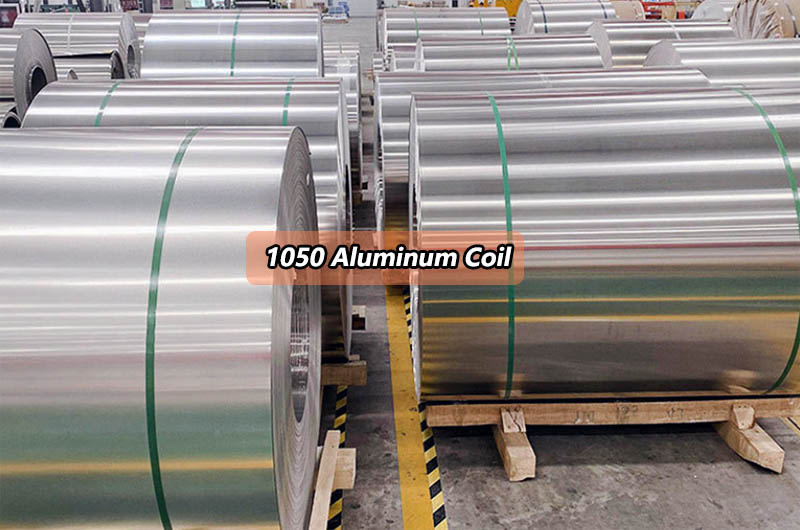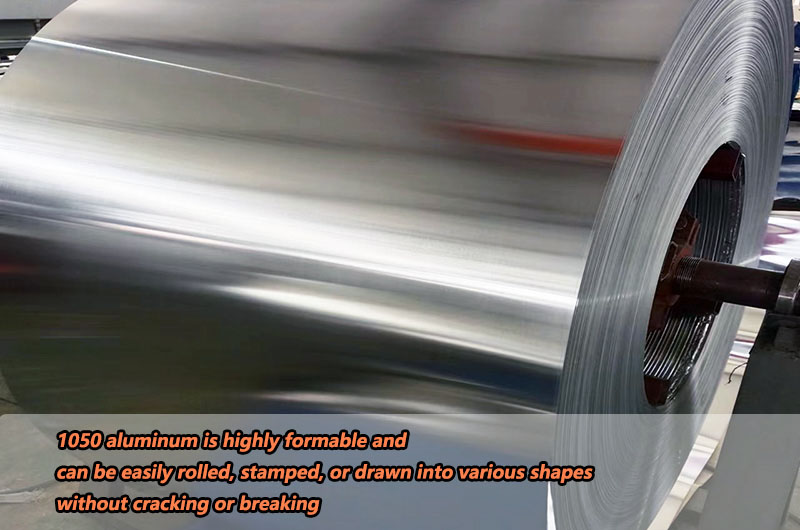1050 aluminum coil refers to a type of aluminum coil made of 1050 alloy. Aluminum alloy 1050 is an industrially pure aluminum alloy with an aluminum content of at least 99.5%. It is known for its excellent corrosion resistance, high thermal and electrical conductivity, and good processability. Due to its high purity, it is commonly used in applications requiring a non-corrosive and highly formable material.

1050 aluminum coil is commonly used for manufacturing purposes in various industries such as the production of food and beverage containers, construction and decorative applications, electronic components, etc. The roll form allows for efficient transportation, storage and processing, making it a versatile material in the manufacturing process.
1050 Aluminum Coil Specifications
- Thickness: 0.1-10.0mm
- Width: 20-2300mm
- Coil Weight: As required
- Surface Treatment: PE Film, Paper Interleaved, Mill finished, Natural Color
Typical Temper 1050 Aluminum Coil
Alloy 1050 aluminum coils are typically available in multiple states, such as H24, H14, H16, H18, etc., each with different mechanical and formability properties. The temper designation indicates the level of hardness and strength the aluminum has been treated to.
| Aluminum Coil | Typical Thickness (mm) |
|---|---|
| 1050 Aluminum Coil | 0.5 |
| 1050 Aluminum Coil | 0.6 |
| 1050 Aluminum Coil | 0.7 |
| 1050 Aluminum Coil | 0.8 |
| 1050 Aluminum Coil | 1 |
| 1050 Aluminum Coil | 1.2 |
Aluminum Coil 1050 Data Sheet
1050 Aluminum Coil Chemical Composition
- Aluminum (Al): 99.5%
- Other Elements: less than 0.5% (impurities such as iron and silicon)
1050 Aluminum Coil Mechanical Properties
- Tensile Strength: 95-125 MPa
- Yield Strength: 35-85 MPa
- Elongation (at 50 mm): 1-29%
- Hardness (Brinell): 27 HB
1050 Aluminum Coil Physical Properties
- Density: 2.71 g/cm³
- Melting Point: 660.32°C (1220.58°F)
- Thermal Conductivity: 229 W/m·K
- Coefficient of Thermal Expansion: 23.1 x 10^-6/°C
1050 Aluminum Coil Electrical Conductivity
Electrical Conductivity (20°C): 61% IACS (International Annealed Copper Standard)
1050 Aluminum Coil Machinability
Aluminum alloy 1050 has good machinability and can be easily worked, but it may produce a powdery chip.
1050 Aluminum Coil Corrosion Resistance
Aluminum 1050 has excellent corrosion resistance in many environments, particularly when it is protected from atmospheric exposure.
1050 Aluminum Coil Weldability
- Excellent formability: 1050 aluminum is highly formable and can be easily rolled, stamped, or drawn into various shapes without cracking or breaking, which is beneficial for many welding processes.
- Welding Methods: 1050 aluminum can be welded using a variety of methods, including MIG (Metal Inert Gas), TIG (Tungsten Inert Gas), and resistance welding. Of these, TIG welding is often favored for its precise control and clean, high-quality welds.
- Cleanliness and Purity: The purity of 1050 aluminum is a double-edged sword when it comes to solderability. On the one hand, its purity contributes to its excellent formability and ease of welding. On the other hand, high purity means more susceptibility to contamination during the welding process. It is important to ensure that the welding area is clean and free of contaminants to avoid problems such as pores and cracks.
- Welding Precautions: When welding 1050 aluminum, precautions must be taken to minimize the risk of problems. This includes using filler materials that match the parent material and avoiding excessive heat input, which can cause deformation and warping.
- Joint Design: Proper joint design is critical. Butt and fillet welds are common in 1050 aluminum and should be designed for good contact and visibility during the welding process. This helps maintain weld quality.
- Post-weld treatments: After welding, post-weld treatments such as stress relief may be required to reduce residual stresses and maintain the integrity of the weld.

NOTE As with any other material, success in welding 1050 aluminum depends on the skill and experience of the welder, the quality of the equipment, and the specific conditions of the welding operation.
1050 Aluminum Coil Applications
Printed Plate 1050 Aluminum Coil
1050 aluminum coil for printing and plate making can better meet its requirements and has strong stability. It not only has a flat surface and high cleanliness, but also has excellent corrosion resistance, good electrical and thermal conductivity, is easy to process and form, and has a relatively high High recycling value.
1050 Thermal Insulation Aluminum Coil
With the continuous improvement of technical level and quality of life, the demand for thermal insulation materials in the market is also increasing, and the requirements for its use and quality are more stringent. 1050 aluminum coil is an aluminum alloy product that is currently used more frequently as thermal insulation materials. .
People Also Searched For Aluminium Alloy 1050
al 1050 h14, a1050 h14, aluminium 1050 price, aa 1050 aluminium, aluminium 1050 h24, 1050 Aluminum Sheet Plate, 1050A Aerospace Aluminum Sheet Plate, 1050 Automotive Aluminium Embossed Heat Shield Sheet, 1050 Aluminum Wire Rod for Electrical Applications, 1050 Aluminum Rod for Fasteners, 1050 3C Digital Aluminum Sheet Strip, 1050 Printing Plate Base Aluminum Strip, 1050 Aluminum Foil for Lacquered EOE POE Lid, 1050 Aerospace Aluminum Wire, 1050 Aluminum Coil for Power Battery Shell, 1050 Aluminum Corrugated Preprinted Sheet, 1050 Aluminum Plate Substrate for Printing, 1050 H18 Aluminum Foil for Lithium-Ion Battery
Related Blog
-
Classification of Aluminum Coils
Aluminum coils are classified based on various factors, including their alloy composition, thickness, temper, and application.
-
Aluminum Coil Stock Management : Complete Specifications
Aluminum Coil Stock has complete specifications and can be customized to meet users' requirements, minimize delivery time, reduce costs and ensure timely completion of projects.
-
11 Differences Between Aluminum Coil vs Aluminum Trim Coil
Delve into the world of aluminum coil and aluminum trim coil as we dissect the 11 differences between them, uncovering their unique characteristics, applications, and how they can best serve your construction and design needs.

